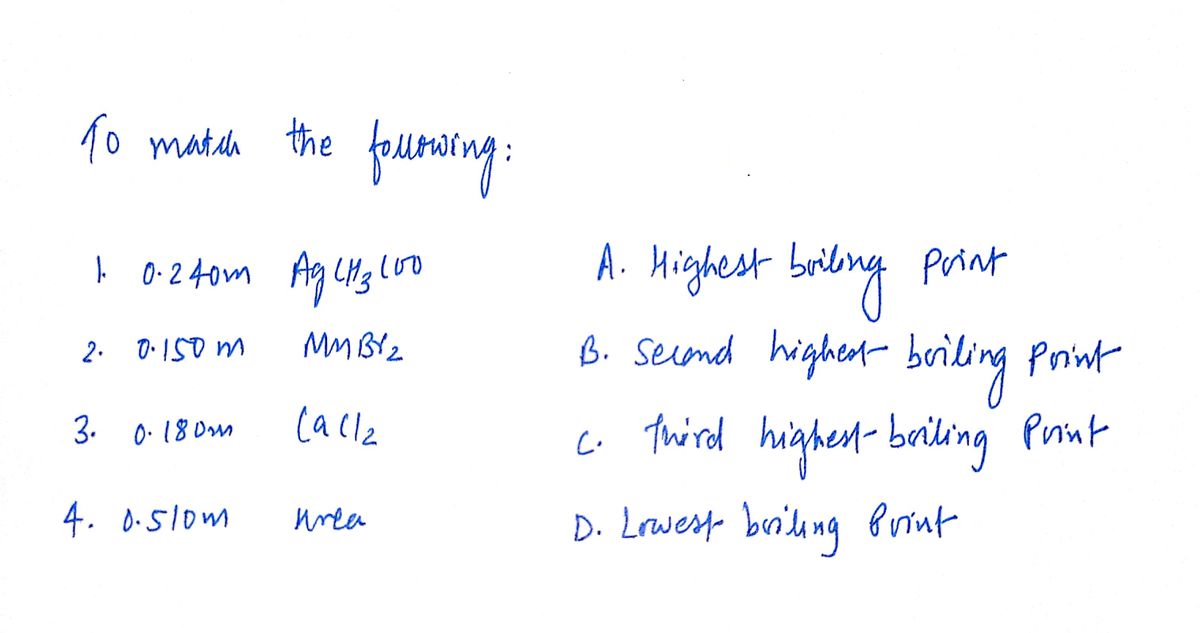Match the following aqueous solutions with the appropriate letter from the column on the right. 1.0.240 mAgCH3COO A. Highest boiling point 2.0.150 m MnBr₂ 3.0.180 m CaCl₂ B. Second highest boiling point C. Third highest boiling point D. Lowest boiling point 4.0.510 m Urea (nonelectrolyte)
Match the following aqueous solutions with the appropriate letter from the column on the right. 1.0.240 mAgCH3COO A. Highest boiling point 2.0.150 m MnBr₂ 3.0.180 m CaCl₂ B. Second highest boiling point C. Third highest boiling point D. Lowest boiling point 4.0.510 m Urea (nonelectrolyte)
Chemistry
10th Edition
ISBN:9781305957404
Author:Steven S. Zumdahl, Susan A. Zumdahl, Donald J. DeCoste
Publisher:Steven S. Zumdahl, Susan A. Zumdahl, Donald J. DeCoste
Chapter1: Chemical Foundations
Section: Chapter Questions
Problem 1RQ: Define and explain the differences between the following terms. a. law and theory b. theory and...
Related questions
Question

Transcribed Image Text:### Educational Exercise: Boiling Points of Aqueous Solutions
#### Match the following aqueous solutions with the appropriate letter from the column on the right.
1. **0.240 m AgCH₃COO**
2. **0.150 m MnBr₂**
3. **0.180 m CaCl₂**
4. **0.510 m Urea** (non-electrolyte)
---
- **A. Highest boiling point**
- **B. Second highest boiling point**
- **C. Third highest boiling point**
- **D. Lowest boiling point**
### Explanation
In this exercise, you are provided with a list of aqueous solutions and their molal concentrations. Your task is to determine the boiling point elevation of each solution, which is influenced by the presence and concentration of solutes. The higher the concentration and number of ions in solution, the greater the boiling point elevation. Non-electrolytes, such as urea, do not dissociate into ions and typically result in a lower boiling point elevation compared to electrolytes at the same concentration.
Expert Solution
Step 1

Step by step
Solved in 3 steps with 3 images

Knowledge Booster
Learn more about
Need a deep-dive on the concept behind this application? Look no further. Learn more about this topic, chemistry and related others by exploring similar questions and additional content below.Recommended textbooks for you

Chemistry
Chemistry
ISBN:
9781305957404
Author:
Steven S. Zumdahl, Susan A. Zumdahl, Donald J. DeCoste
Publisher:
Cengage Learning

Chemistry
Chemistry
ISBN:
9781259911156
Author:
Raymond Chang Dr., Jason Overby Professor
Publisher:
McGraw-Hill Education

Principles of Instrumental Analysis
Chemistry
ISBN:
9781305577213
Author:
Douglas A. Skoog, F. James Holler, Stanley R. Crouch
Publisher:
Cengage Learning

Chemistry
Chemistry
ISBN:
9781305957404
Author:
Steven S. Zumdahl, Susan A. Zumdahl, Donald J. DeCoste
Publisher:
Cengage Learning

Chemistry
Chemistry
ISBN:
9781259911156
Author:
Raymond Chang Dr., Jason Overby Professor
Publisher:
McGraw-Hill Education

Principles of Instrumental Analysis
Chemistry
ISBN:
9781305577213
Author:
Douglas A. Skoog, F. James Holler, Stanley R. Crouch
Publisher:
Cengage Learning

Organic Chemistry
Chemistry
ISBN:
9780078021558
Author:
Janice Gorzynski Smith Dr.
Publisher:
McGraw-Hill Education

Chemistry: Principles and Reactions
Chemistry
ISBN:
9781305079373
Author:
William L. Masterton, Cecile N. Hurley
Publisher:
Cengage Learning

Elementary Principles of Chemical Processes, Bind…
Chemistry
ISBN:
9781118431221
Author:
Richard M. Felder, Ronald W. Rousseau, Lisa G. Bullard
Publisher:
WILEY